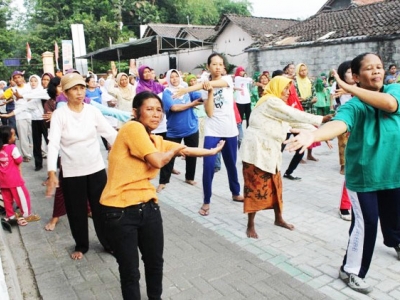Maintaining the Health of the Elderly with the Right Exercise

Sports or physical exercise is an integral part of efforts to improve health and fitness status. A person with low physical activity has a higher risk of various health problems. In addition to playing a role in promotive and preventive efforts, exercise is also crucial in therapy and rehabilitation programs for multiple types of health disorders. The planned and structured exercise involves repetitive body movements to improve physical fitness.
"Physical activity is any body movement that requires energy, such as walking, dancing, caring for grandchildren, and so on," said Agung Prabowo, a student at the Faculty of Sport Sciences UNY, in socializing the benefits of exercise for the elderly in Bajang Hamlet. According to him, intense exercise can trigger the brain to release the hormones endorphins, adrenaline, serotonin, and dopamine. "Exercise can make us happy, help us manage our emotions, and even improve our mood," said Agung, Monday (11/4). Endorphins are responsible for relieving pain and reducing stress, while dopamine and serotonin can improve appetite and regulate sleep cycles. In addition, adrenaline can balance stress hormones to make the mood better.
Agung said that the elderly are often less productive due to changes in body function, muscles, bones, joints, and breathing which are prone to health problems. Muscles in the elderly become stiffer and reduce muscle strength. Exercise can increase muscle strength. Joints that are difficult to move cause movement to be limited, so the elderly needs to practice movements that improve flexibility
Some of the benefits of exercise in the elderly include prolonging life, making healthy and improving heart, muscle, and bone endurance, making the elderly more independent, preventing obesity, reducing anxiety and depression, and gaining higher self-confidence. Exercise can also reduce the risk of diabetes mellitus, hypertension, and heart disease. In general, exercise in the elderly supports health by increasing appetite, improving sleep quality, and reducing the need for medication. Good exercise for the elderly is walking, light jogging, cycling according to their respective abilities, yoga, and light aerobics.
Meanwhile, Farhan Zain Fadillah, a student of Sports Coaching Education, explained that gymnastics is a sports activity that involves physical activity by moving certain body parts with specific and selective movements. The benefits of gymnastics include training and building body strength, making the body more flexible, training the body's coordination ability, slowing down the aging process, and increasing self-confidence. However, according to him, the principle of exercise in the elderly is always to maintain safety, exercise regularly, and not be too heavy. In addition, it will be safe not to have any strenuous exercise for those whose blood pressure is 180 mmHg and has a severe illness.
This activity is one of UNY's KKN programs in Bajang Wijirejo Village, Pandak Bantul, to increase public knowledge about health. A total of 20 residents, the majority of whom are local elderly, participated in this activity. One of the participants, Julehah, was pleased with the additional knowledge. "I came to know the importance of exercise and the benefits of exercise for health," he said. (Dedy, Tj. Lak)

